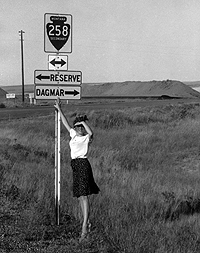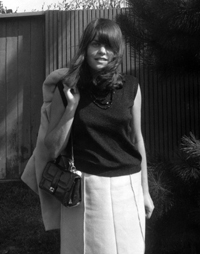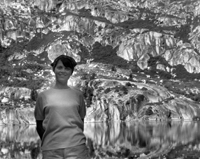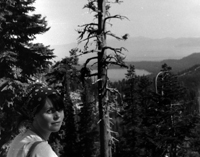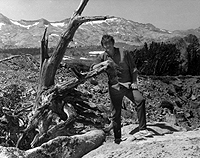|
Vaughan Family Timestream® Maps |
| Home Biography People Places Multimedia: Making It Work On the Water Writings/Presentations |
Driving the Queen's Highway, Canada
1967: An Act of Kindness
In 1967 I bought a V-8 Ford Fairlane in Elyria, Ohio, and we drove to California for a short summer visit with Dad and Clarice in San Mateo. Dagmar and I drove back to Oberlin along a northern route, angling through many Indian reservations and delightfully passing near enough to Dagmar, Montana, to see a highway sign pointing in that direction.
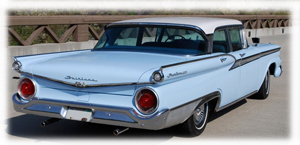 Then to the Trans-Canada (Queen's Highway) through Medicine Hat, Winnipeg, and Thunder Bay, to Sault Ste. Marie, with a southbound crossing of the 26,372 foot long Mackinac suspension bridge connecting upper and lower Michigan in the USA. It was somewhere around Piapot, Canada, I think, that Dagmar and I were treated to an act of genuine kindness.
Then to the Trans-Canada (Queen's Highway) through Medicine Hat, Winnipeg, and Thunder Bay, to Sault Ste. Marie, with a southbound crossing of the 26,372 foot long Mackinac suspension bridge connecting upper and lower Michigan in the USA. It was somewhere around Piapot, Canada, I think, that Dagmar and I were treated to an act of genuine kindness.
I did all of the driving on this trip because Dagmar did not have a driver's license in Germany or in Ohio. She was happy to walk to local places and take the train or bus to farther destinations. So late in the night I ran out of steam, and we pulled off the road into some bushes, stretching out comfortably across the front and back seats. These were about the widest bench seats ever built in an automobile. Dagmar called the car a "Straßenkreutzer." We nicknamed her "The Blue Cow."
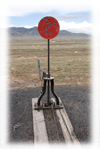 At sunrise, there was a knock on the car window. Groggy, I expected to see a Mountie ready to give us a loitering ticket. Instead, it was a diminuative, white-haired lady in a robe standing on the downhill away-from-the-road side. Dagmar rolled down her window. The lady smiled and asked if we would like some breakfast and a shower.
At sunrise, there was a knock on the car window. Groggy, I expected to see a Mountie ready to give us a loitering ticket. Instead, it was a diminuative, white-haired lady in a robe standing on the downhill away-from-the-road side. Dagmar rolled down her window. The lady smiled and asked if we would like some breakfast and a shower.
 So we locked the car and she led us down a steep path to the railroad tracks then eastward along the gravel bed a short way to a small home near a series of switches. Her husband was in charge of this switchyard on the flats, now visible in the daylight, and with that job came a place to live. But he was dead, now. And our friend had stayed on in the cottage which had been her home for 47 years, she said, because the switch yard had been automated and a real person was redundant.
So we locked the car and she led us down a steep path to the railroad tracks then eastward along the gravel bed a short way to a small home near a series of switches. Her husband was in charge of this switchyard on the flats, now visible in the daylight, and with that job came a place to live. But he was dead, now. And our friend had stayed on in the cottage which had been her home for 47 years, she said, because the switch yard had been automated and a real person was redundant.
We had hot showers in a tiny pink-tiled bath, then pancakes, and scrambled eggs, and sausage. And we talked and talked and talked until about noon, when she made us sandwiches and we talked some more and reluctantly made excuses about school starting and needing to drive on.
We received a Christmas card from her every year thereafter, and Dagmar also wrote lengthy informative notes in her own season's greetings sent to Canada. Then, one year, the cards stopped coming.
I miss her as much as my own family and love her for her fearless kindness on the prarie.
"Straßenkreuzer" ist im deutschen Sprachraum die umgangssprachliche Bezeichnung für Autos aus meist US-amerikanischer Produktion, die in ihren Ausmaßen und ihrer Gestaltung einen teilweise als übertrieben empfundenen Prunk verdeutlichten. Der Begriff vergleicht diese Wagen mit großen Kriegsschiffen, siehe Kreuzer (Schiffstyp).
Straßenkreuzer is in the German language, the colloquial name for cars of mostly American production which sought to clarify a partially perceived as exaggerated pomp in their dimensions and their design. The term compares this car with large warships, see Kreuzer (type of vessel).
Characteristics of such vehicles are a length of sometimes well over 5 meters even with coupes, broad, chromed grille and in the 1950s, partly huge tailfins. Motorized vehicles were those with high-volume, high-consumption engines. Manufacturers of road cruisers were essentially the "Big Three" General Motors, Ford and Chrysler; the most impressive with its luxury brands Cadillac and Lincoln.
